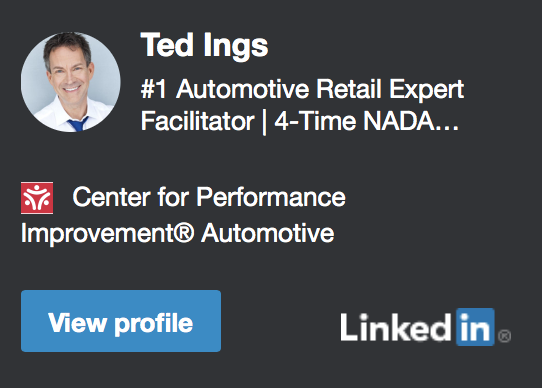Service Advisor Training: Speed Up the Service but Slow Down the Sale
By Ted Ings, Executive Director
Everyone is short on time, and the pinch is felt by everyone in the service industry.
Fast food chains make their money on feeding people quickly. Speedy service centers promise an oil change in ten minutes or less. But there’s an argument for slowing down to serve the customer better. And as a business or professional looking to maximize your earning potential, it pays to slow down the sale.
WHO NEEDS TRAINING AT YOUR DEALERSHIP?
Kevin Davis, in his New York Times bestseller “Slow Down, Sell Faster!: Understand Your Customer's Buying Process and Maximize Your Sales”, explore the topic from the standpoint of earning new customers. But the premise applies to your current service customers also.
What Slowing Down Does
For the automotive service industry, going slower sounds like a bad idea. But keep in mind, it’s the check-in process in the service drive and the phone skills that we’re addressing. The actual automotive repair and service stage should always be as fast and efficient as can be while maintaining accuracy.
Slowing down stages that involve selling help in a few ways:
Book a Complimentary "Ask the Expert" Discovery Call with Ted Ings
Exclusively for Dealers, Executive Managers and OEM/Lenders/Suppliers
• It builds a trusting relationship with the customer.
• It demonstrates understanding and caring about their needs.
• It allows you time to explain the benefits and build value in your offering.
Naturally, the next hurdle is in HOW to slow it down without making the customer frustrated or impatient. We all know that when a customer is left waiting too long, the opportunity to close a sale dwindles.
Slowing down the sale needs to be ACTIVE. There can’t be time for a customer to tap their watch or think about where they need to be next. As a service advisor, keep the customer engaged.
Here are solid ways to engage the customer effectively for longer:
• Complete a thorough walkaround with the customer participating. Ask the customer to turn the wheels and pop the hood. Explain why you’re checking the items on your list.
• Ask open-ended questions about their vehicle. Compliment their vehicle choice and ask why they’ve chosen the particular model, what features they like best, and how they’ve enjoyed the vehicle so far.
• Walk with the customer to their next stop, whether it’s the door, to check in with the shuttle, or to the customer lounge.



